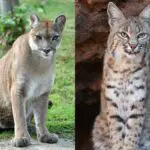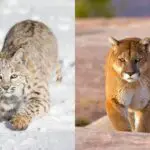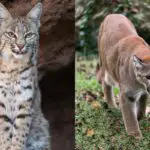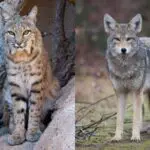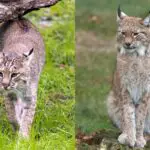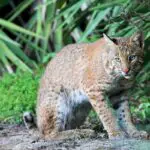Almost double the size of domestic cats, bobcats are medium-sized felines that are rarely spotted by humans.
That is despite having the greatest range of any North American feline. However, even though this species of cat is nocturnal and elusive, we still know lots about them.
Thanks to research efforts, we know all about the climates they prefer to live in, what they like to hunt, what they look like, and so much more.
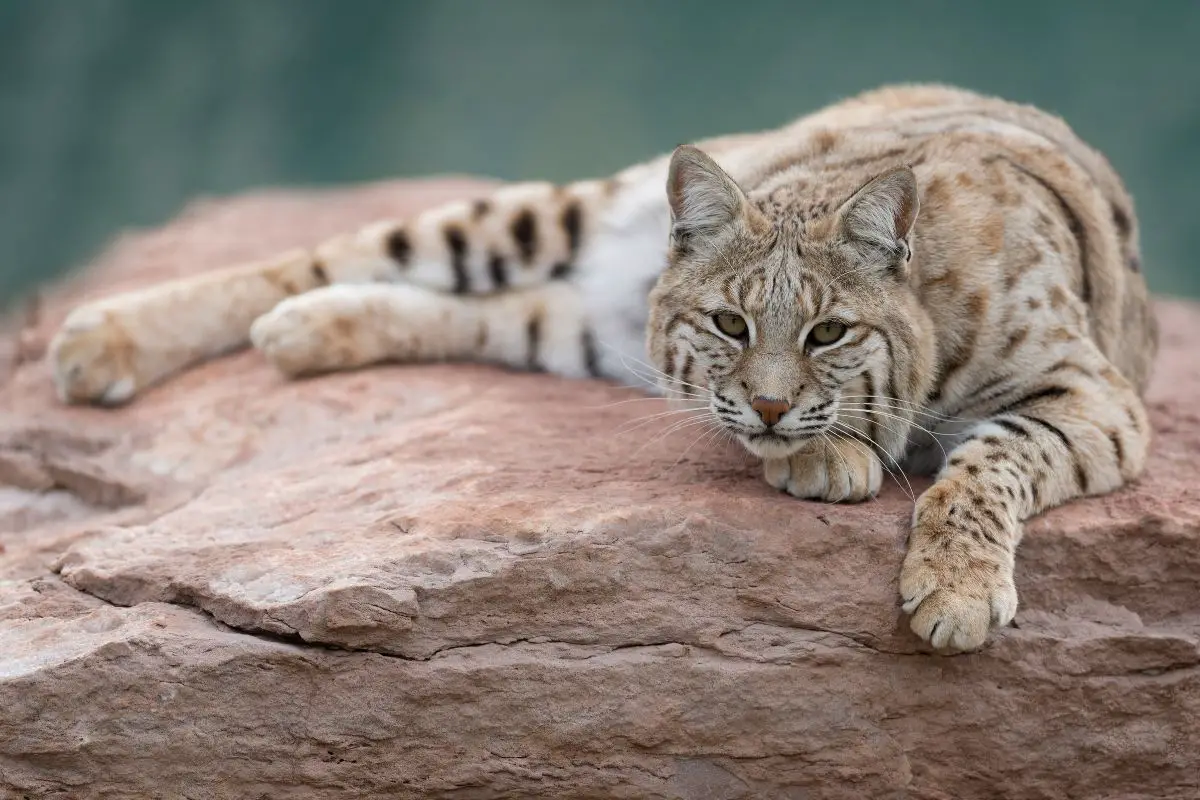
Today, we want to improve your knowledge and understanding of the bobcat. Therefore, we’ve put together a comprehensive guide telling you everything you need to know.
If you want to learn more about this beautiful species of cat, stick around!
Overview
Also known as wildcats, the bobcat is a medium-sized animal native to the United States, southern Canada, and northern Mexico.
Adapting well to a wide range of habitats, they can primarily be found in swamps, forests, and deserts. They are occasionally found in suburban areas too.
However, due to the cat’s elusiveness and nocturnal way of life, the cat is very rarely seen by humans.
Approximately twice the size of domesticated cats, bobcats have an average lifespan of 10 to 12 years, weigh between 11 and 30 lbs, and grow anywhere from 26 to 41 inches long. Their tails reach lengths of 7 inches.
With a stable population trend and a carnivorous diet, this brown and white cat with a black-tipped tail currently thrives in the wild.
Classification
- Kingdom: Animalia
- Phylum: Chordata
- Class: Mammalia
- Family: Felidae
- Order: Carnivora
- Genus: Lynx
- Scientific Name: Lynx rufus
- Common Name: Bobcat
- Locations: Central America and North America
- Conservation Status: Least Concern
- Diet: Carnivore
Characteristics
Reaching lengths of 26 to 41 inches, the bobcat is a brown or brownish red species of cat that has a white underbelly, and a long black-tipped tail.
Named after its tail, which appears to be “bobbed”, the bobcat has long legs, tufted ears, and large paws.
Its tail can reach lengths of 7 inches, whilst its ears are quite similar to those of the bobcat’s largest relative, the Canada lynx.
Weighing up to 30 lbs, the bobcat has an average lifespan of 10 to 12 years, although some have been known to live for up to 15 years.
They are capable of reaching speeds of 34 mph and reach sexual maturity after 1 to 2 years.
Interesting Facts About Bobcats?
Before we go any further, we’d like to share some interesting facts about bobcats!
- The estimated bobcat population size is currently 1,000,000.
- Bobcats usually feed on rabbits, mice, and deer.
- Bobcats will happily take down prey much bigger than themselves.
- The biggest threat to the bobcat is habitat loss and hunting.
- Bobcat young are called kittens.
- Bobcats prefer to live in woodlands, swamplands, and semi-deserts.
- This species of lynx is the smallest.
- Bobcats are usually misidentified as domestic cats, panthers, other species of lynx, and even mountain lions.
- They live solitary lives.
- A female bobcat will have a territory of approximately 6 sq miles in size, while males usually have a territory of roughly 25 sq miles in size.
What Is A Group Of Bobcats Called?
Despite being a solitary species of cat, it isn’t uncommon for bobcats to cross paths. When they do, this group can be called one of three names.
Those three names are clowder, clutter, or pounce.
We don’t know about you, but a pounce of bobcats sounds pretty cool!
Are Bobcats Intelligent?
Research, studies, and observation of bobcats have shown that bobcats are a highly intelligent species.
For starters, they have a good degree of curiosity, which shows they are somewhat intelligent.
On top of that, they are mammals. This is important because mammals are generally considered to be the most intelligent animals on the planet.
Interestingly, bobcats are more intelligent than a lot of other mammals too.
Compared to other species of cats and other mammals, the bobcat has large cerebral hemispheres. This is the part of the brain that affects intelligent behavior.
This intelligence helps the bobcat when hunting. Thanks to their intelligence, they can hunt with stealth before quickly pouncing on their prey.
How High Can Bobcats Jump?
Like most species of cat, the bobcat is an excellent jumper. Despite their size, they have enough power in their legs to easily clear a six-foot fence.
In fact, they could almost clear two six-foot fences as they are known to be able to jump up to 12 feet high.
The bobcat’s jumping capabilities actually cause problems in some suburban areas as locals struggle to build high enough fences to keep them out.
How Do You Tell A Male Bobcat From A Female?
If you’re lucky enough to ever spot a bobcat in the wild, you’ll be pleased to know that their sex can be easily identified.
The most apparent difference between male and female bobcats is their size. Fully-grown adult males grow to approximately 3 feet in length and weigh anything between 20 and 30 lbs.
On the other hand, adult females only reach lengths of 2 feet long and a weight of roughly 11 lbs.
Experts can also tell the difference between males and females by looking at their tracks. A bobcat male’s tracks are a lot bigger and rounder than a female’s tracks.
Location can also be key, as a male’s territory can be twice as big as a female’s.
Kittens are another sign. If a bobcat has kittens with it, it is most likely a female bobcat.
How Fast Can A Bobcat Run?
Bobcats aren’t slow. In fact, they’re actually very fast. Bobcats have a top speed of 34 mph.
Despite this speed, bobcats will do all they can to avoid using the energy needed to get to their top speed.
To avoid doing so, they would prefer to stalk their prey for 2 to 7 miles if it meant not having to chase prey down at a speed that burns a lot of energy.
Care

There is great debate as to whether or not bobcats should be kept as pets. Many argue that they should be, whilst others disagree, believing the bobcat should stay a wild animal.
We’ll now give you a rundown of what people can expect when they decide to keep a bobcat as a pet.
Does A Bobcat Make A Good Pet?
Despite what many people believe, a bobcat doesn’t make a good pet unless you’re experienced. After all, they are wild animals.
As a result, keeping a bobcat as a pet can actually create a stressful and dangerous environment.
Only expert exotic cat handlers should consider keeping a bobcat as a pet.
Even if the bobcat has been hand reared they still don’t make a great pet.
This is because the maintenance and upkeep costs are extremely high. Having said that, they are a better choice than other exotic pets.
On top of that, bobcats need an incredibly large amount of space to roam. This can’t be provided for them in a house.
Are Bobcats Hard To Take Care Of?
If a bobcat has been hand reared, it isn’t as hard to take care of as a wild bobcat. That doesn’t mean it’s easy, but it can be done.
As a matter of fact, bobcats are generally considered to be the easiest exotic feline to keep as a pet. However, they are still very high maintenance when compared to other, domesticated felines.
Owners should be ready to experience bouts of aggression, a need for the regular maintenance and upkeep of outside enclosures, issues related to spraying, and potentially destructive behavior.
How Much Does A Bobcat Cost To Have As A Pet?
There’s no denying that keeping a bobcat is costly. For starters, you’re going to pay a lot more to buy the cat than any domesticated cat. This cost could be anywhere from $900 to $2,500.
The price could be a little more or a little less.
This may not seem too bad, but when you factor in other costs things get steep very quickly.
The housing of a bobcat is pricey. They need a large outdoor enclosure that could cost up to $1,000 to build. The area then needs to be fenced off for extra protection.
Of course, there’s then the food costs too. The food costs are the most costly aspect of keeping a bobcat. Bobcats need large, protein-rich foods. This includes high-quality raw meats.
When dealing with exotic pets, veterinarian costs are also a lot higher.
How Big Does A Bobcat Enclosure Need To Be?
Ideally, pet bobcats should have access to indoor and outdoor housing.
There are some bobcat owners that use doggie doors to give their bobcat free reign between both enclosures. This is probably the best way to go if you want to keep the cat happy.
The outdoor enclosure has to be a decent size. It could be argued that this enclosure should be as big as possible because the bobcat will appreciate as much space as possible.
If the bobcat will spend most of its time in the enclosure, the enclosure needs to be larger so that the cat has more freedom.
At a minimum, a bobcat enclosure should be 24x24x12 ft.
How Much Does A Baby Bobcat Cost?
The price for bobcat kittens ranges massively. Some exotic pet stores will sell a baby bobcat for $350, while others will sell them for up to $2,500.
This makes it quite hard to work out what price is right. Online, there are a handful of listings for $1,800. There are also listings for $2,500.
On average, baby bobcats can be bought for $900. The price varies so much because of demand. If there is a bigger demand for the bobcat, expect prices to rise. If there isn’t, expect prices to drop.
Habitat
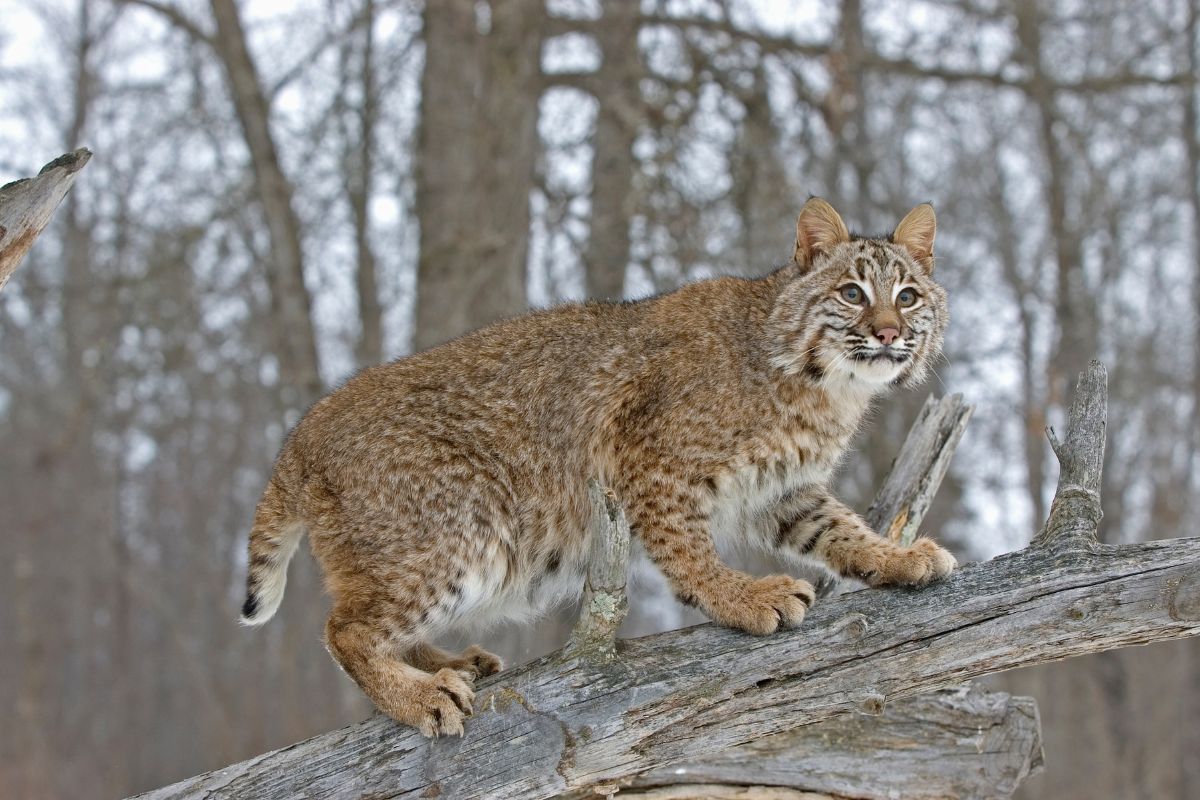
Bobcats are native to northern Mexico, southern Canada, and the United States. As a result, their habitats vary quite a lot.
Luckily, the bobcat is super adaptive. It can successfully adjust to a wide range of climates and habitats to ensure it survives and thrives.
The next part of this guide focuses on the bobcat’s habitat.
What Is The Most Common Habitat For A Bobcat?
Bobcats don’t commonly live in one habitat more than another. Instead, their range is extremely wide and their habitats are incredibly varied.
Having said that, there are a select few habitats that the bobcat prefers to live in over others.
Typically, the bobcat will inhabit grasslands, forests, woodlands, brushlands, desert edges, marshlands, wetlands, and coastal swamps.
Out of all their habitats, studies would suggest that bobcats prefer to live in deciduous or coniferous forests over other habitats.
Where Can I Find A Bobcat Den?
Bobcat dens aren’t easy to find, but if you know what you’re looking for you have a much better chance.
Most female bobcats den in rock piles, caves, brush piles, hollow trees, and abandoned beaver lodges. If you stumble across one of these dens, you’ll first spot the lining of the bobcat den.
The bobcats line their den with soft debris. This debris can include grass and dry leaves. Females will have several dens in their territory.
A male bobcat den is harder to find as they cover an area of 25 sq miles.
Where Do Bobcats Stay During The Day?
Bobcats are nocturnal so they don’t tend to venture out much, if at all during the day. During the day, bobcats will stay in their den and rest.
Most of their day consists of sleeping. Only at dusk will they then emerge in order to look for food.
Their activity usually peaks approximately three hours before sunset until midnight. They will venture out during the day and before sunrise but they prefer to rest.
How Do Bobcats Make Their Homes?
Bobcats usually make themselves several dens, spread across their territory. This is so that they have enough shelter and places to rest.
Aside from offering the bobcat a place to live, their dens offer protection against predators. Having multiple dens across their territory gives them more places to flee to when being pursued by a predator.
To create a den, the bobcat first needs to find the perfect place. As we mentioned above, the perfect place for a bobcat to build a shelter is in hollow trees, caves, rock piles, abandoned beaver lodges, and brush piles.
Once the bobcat has identified the perfect den, it will fill it and line it with dry leaves and grass. These materials are depressed to create a warmer, more comfortable place for the bobcat to live.
More often than not, the bobcat will make smaller dens in the locations they don’t frequently visit.
What Attracts Bobcats To Your Yard?
More and more bobcats are entering suburban areas. With this comes an increased chance of a bobcat entering your yard.
If you’ve experienced a bobcat entering your yard, there could be a number of reasons for it.
Firstly, the bobcat could simply be passing through to get somewhere else. Secondly, and probably the most likely reason is that they’ve been attracted by birds or squirrels.
They might simply have come to your yard to feed.
To stop bobcats from getting into your yard, you should build a fence around your property. This fence should be at least 6 feet tall and stand at a 45-degree angle. It should also be 16 inches wide.
Should I Worry About A Bobcat In My Yard?
Generally speaking, you will never need to worry about a bobcat. They are extremely elusive and will very rarely if ever enter your yard.
Bobcat attacks on humans are virtually unknown. However, you might still want to be cautious, especially if you have pets. If you know there’s a bobcat in your yard, keep your pets and yourself clear.
A bobcat will happily attack a dog if it can. While it probably won’t hurt you, it’s always best to leave a wild animal alone. Certainly don’t try to stroke it.
Which State Has The Most Bobcats?
Wild bobcats are found in 48 US states, making it a lot harder to calculate just how many bobcats there are and which state has the most.
However, based on statistics, it is believed that Florida currently has the biggest population of bobcats. It is thought that almost 304,000 bobcats live in the Sunshine State.
While this is great, it’s worth noting that this number is actually in decline.
This is unlike Georgia where the population of bobcats has risen from nearly 210,000 bobcats to almost 250,000.
To find a conclusive answer to this question, more research and observational studies would have to be performed.
Lifespan
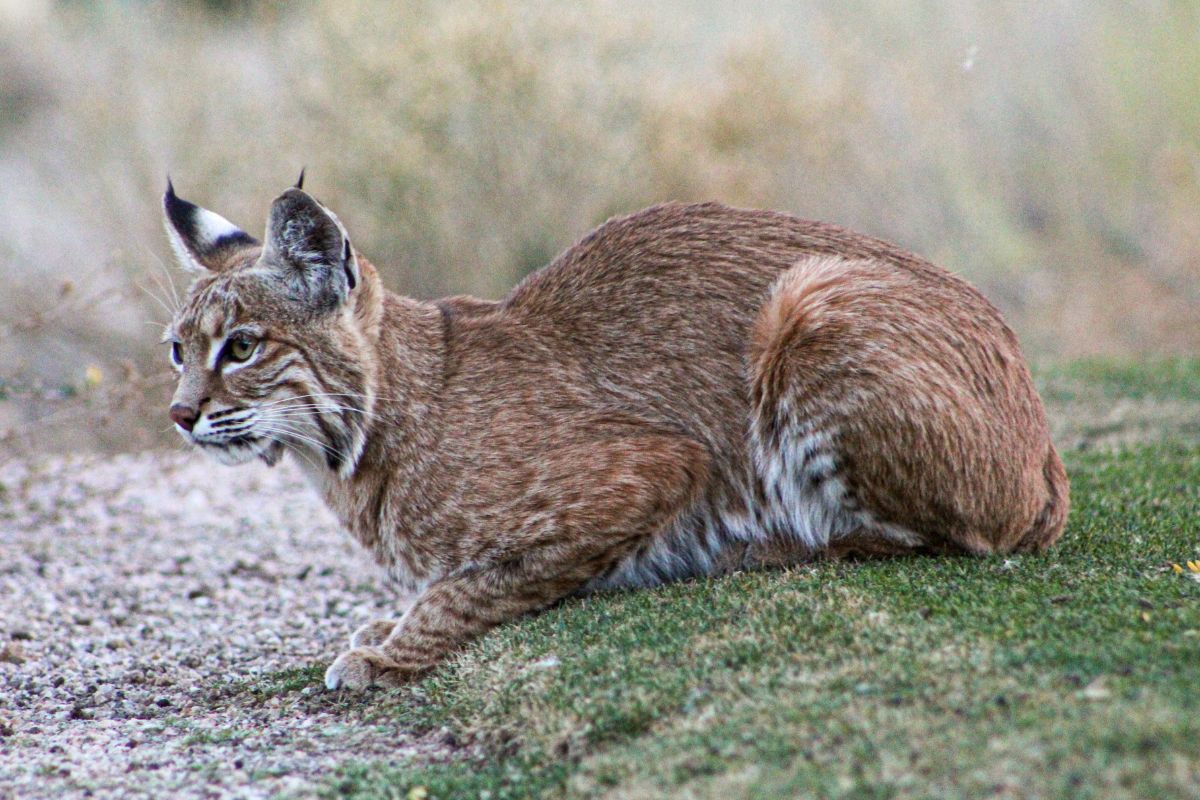
A bobcat’s lifespan varies depending on whether it lives in captivity or in the wild. Let’s look at both now!
How Long Does A Bobcat Live In Captivity?
In captivity, a bobcat might live for up to 25 years. This is because they face no competition for food, have regular care, and don’t come face to face with any predators.
What Is The Lifespan of A Bobcat In The Wild?
In the wild, things are very different. Bobcats are thought to live for up to 12 years. There are some cases where they have been known to live for 15 years.
However, the average life expectancy for wild bobcats is just 7 years. This is because they face many more challenges. Of course, one of these is predators.
Other challenges they face are loss of habitat, the hunt for food, and the need for shelter.
Life Cycle
When it comes to the life cycle, bobcats are quite interesting. They have a variety of traits and habitats that they follow in order for the population to survive and thrive. This is what we’ll look at now!
What Time Of Year Do Bobcats Have Babies?
Usually, male and female bobcats mate in February or March. Male bobcats will mate with several females and females will mate with multiple males.
Most female bobcats then give birth between April and July.
Most litters consist of 2 to 4 kittens. When born, bobcat kittens are blind, helpless, and very small. They rely on their mother for everything. Without their mother’s care, they would quickly die.
How Long Does A Bobcat Stay With Its Mother?
Females will choose a secluded den to raise their litter safely. The bobcat kittens will then stay with their mother for 9 to 12 months.
Because bobcats are solitary animals, bobcat babies must then fend for themselves.
Mothers will even turn their back on their young in an attempt to get them to go their own way.
During the period of time a baby bobcat stays with its mother, the bobcat will learn how to survive.
The mother will show the baby bobcats how to make a den, how to hunt, and how to avoid predators.
How Long Are Bobcats Pregnant?
Once pregnant, it usually takes a female bobcat approximately 44 days to give birth. It can take fewer days or more depending on a number of factors, but this is the average.
How Often Do Bobcats Reproduce?
Female bobcats usually breed once a year. The time of year they reproduce will always be around spring.
Do Bobcats Stay In The Same Area?
Bobcats typically find one place they can mark as their own territory and stay there. They do not migrate. Therefore, a bobcat could spend virtually its whole life in one area.
The only time a bobcat will move out from the area it lives is in the event of extreme conditions.
However, this move is normally only temporary, with the bobcat doing everything it can to move back into its territory as soon as possible.
As far as baby bobcats are concerned, they will leave their territory in search of an unoccupied territory when they leave their mother.
Male bobcats will travel great distances to find a suitable territory they can mark as their own.
Bobcat Anatomy And Appearance
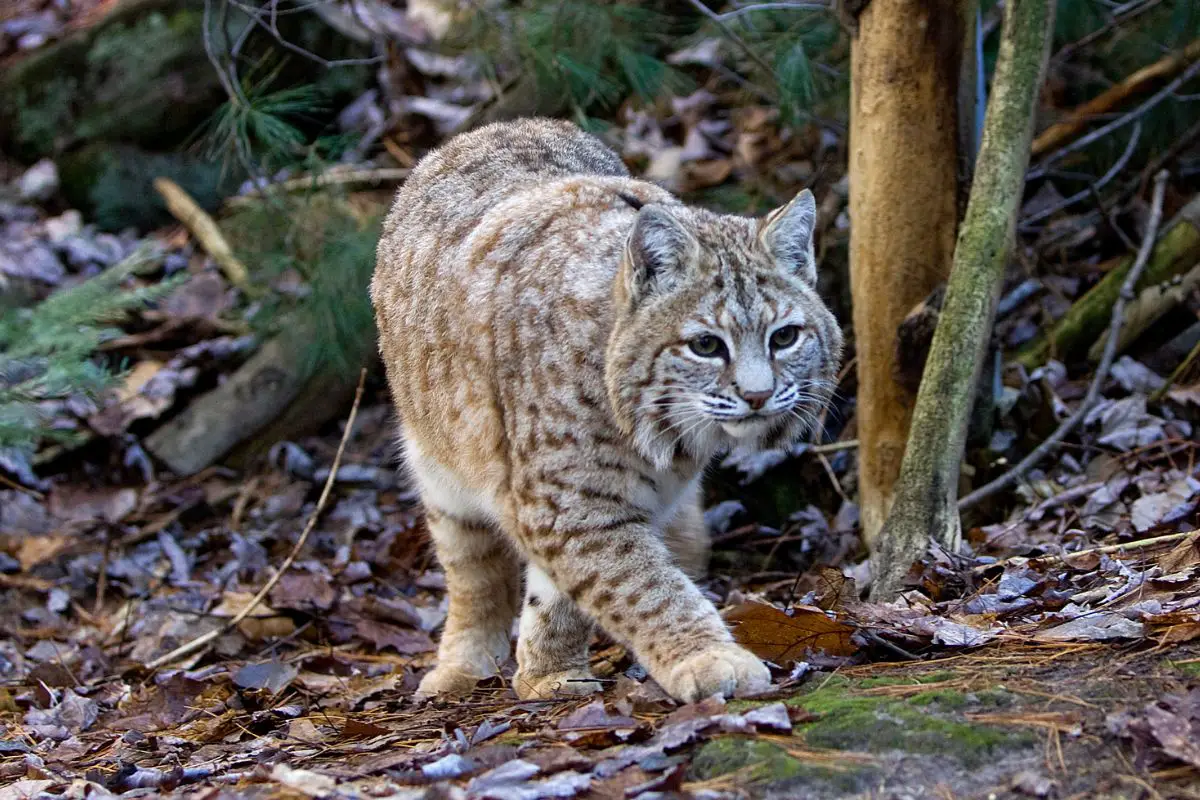
Bobcats are double the size of domesticated house cats. They have a distinctive stubby tail, long legs, and a body that grows up to 49 inches long from its head to the base of the tail.
An adult bobcat will stand at approximately 24 inches tall and weigh 11 to 30 lbs. It gets the name bobcat from its “bobbed” tail.
Similar to its larger relatives, the bobcat has tufted ears and large paws. When it comes to color, most bobcats are brown or brownish red. They have a white underbelly and a black-tipped tail.
Their dark fur is also covered in darker brownish black markings.
In regard to the bobcat’s anatomy, the species has a powerful jaw and long pointed canine teeth.
They also have super sharp, retractable claws, a spotted coat, and large ears. These features aid the cat when hunting.
Its long, muscular legs help it run at speeds of up to 34 mph.
Bobcat Diet And Prey
As a carnivore and a skilled hunter, the bobcat doesn’t have too much trouble catching its prey.
They tend to feed on smaller mammals such as rabbits, hares, mice, and birds. However, they will also hunt larger animals if necessary.
One larger animal the bobcat regularly hunts is deer.
As a result, a bobcat’s diet largely depends on what it can find and how easy the prey is to hunt.
A study published in the Journal of Wildlife Management declared that snowshoe hares are the primary food source for bobcats in Maine.
Other studies have found that squirrels are the most popular food source in other states. A bobcat’s diet will consist of roughly 2 lbs of meat a day.
Bobcat Predators And Threats
Bobcats might be skilled hunters, but that doesn’t mean they aren’t also hunted occasionally. Like most animals, the bobcat has its predators.
The most common predators that hunt bobcats are coyotes, wolves, and mountain lions. Some foxes and owls will also hunt for kittens. Sadly, there are also humans that hunt for bobcats.
In fact, out of all of the predators the bobcat comes face to face with, humans are one of the ones bobcats fear the most.
Aside from predators, bobcats also face other threats that could see them suffer or die.
Most of these are the result of human activity. Land development, habitat destruction, and trapping are the biggest threats bobcats face.
Bobcat Relationship With Humans
As a result of hunting, habitat destruction, trapping, and general interference, humans, and bobcats don’t have a good relationship.
Despite the bobcat population thriving in recent years, there are areas where the population has declined.
Florida is a good example. Due to land development and the destruction of the bobcat’s habitat, bobcat numbers have dropped.
Thankfully, the majority of bobcat populations are rising in other states.
The sad thing about this is that bobcats pose no threat to us. Bobcat attacks on humans are virtually unknown. Almost everyone that’s come face to face with a bobcat hasn’t faced any problems.
Bobcat Conservation Status
Compared to other exotic cat species, the bobcat is thriving. There are believed to be at least 1,000,000 bobcats currently living in the wild.
As a result, the bobcat is currently classified as Least Concern (LC). This classification was given by the International Union for Conservation of Nature (IUCN).
This goes to show that current conservation efforts are working well, despite the continued hunting of bobcats and the destruction of their habitat.
Despite the growth of the bobcat population, the biggest threat the species faces is still humans.
Frequently Asked Questions
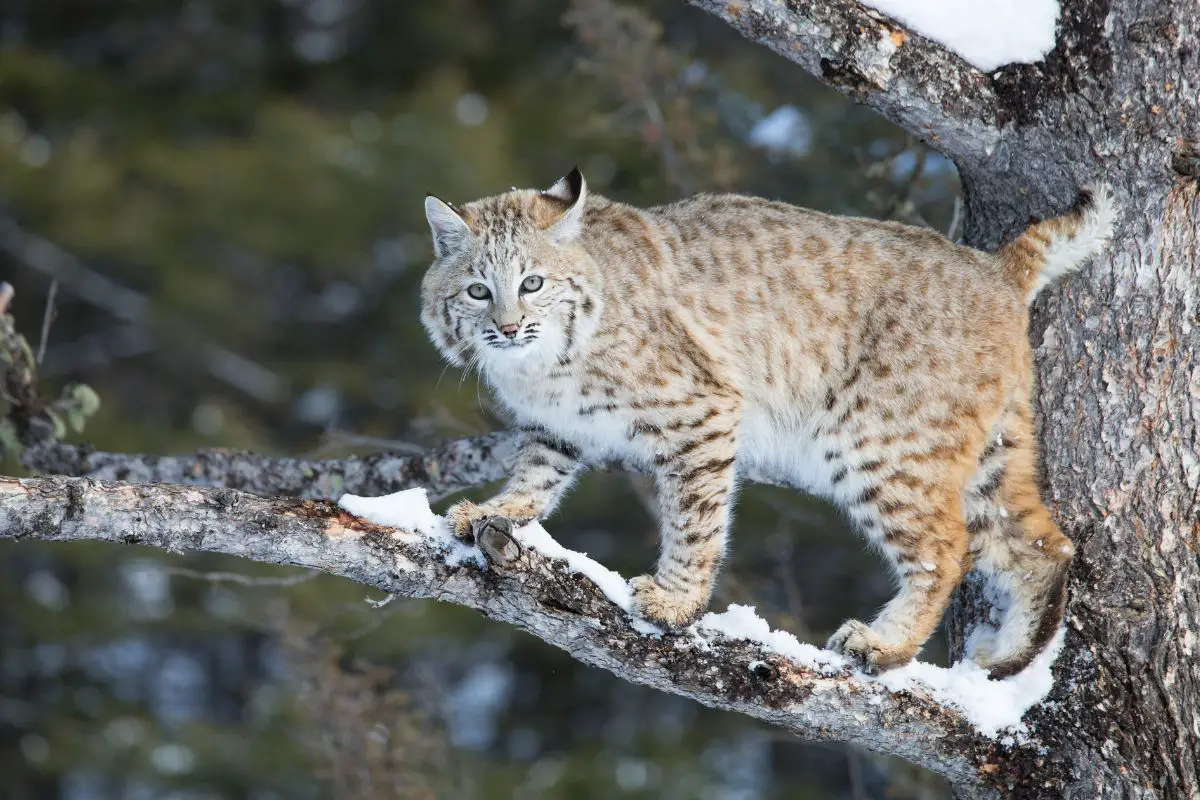
You should now know a lot more about the bobcat. Before we finish this guide, we’d like to provide you with a comprehensive FAQ section to answer some of the most commonly asked questions.
Are Bobcats Herbivores, Carnivores, Or Omnivores?
Bobcats are carnivores. That means they have a diet that consists of meat.
When it comes to what the bobcat likes to eat, they usually hunt rabbits, hares, mice, and birds. They will also hunt larger mammals such as deer if necessary.
It isn’t uncommon for bobcats to eat rodents, lizards, and snakes too.
How Fast Is A Bobcat?
Bobcats aren’t slow. When chasing down prey or fleeing from a predator, a bobcat is capable of reaching a top speed of 34 mph.
Having said that, they will do all they can to avoid running at those speeds as it takes a lot of energy for the cat to run that fast.
How Many Babies Do Bobcats Have?
Female bobcats usually give birth to 2 to 4 kittens once a year. However, it is also possible for females to give birth to litters of six kittens.
Most bobcat kittens are born between April and July. They will stay with their mother for the first 9 to 12 months of their lives, learning how to hunt, build dens, and hide from predators in the process.
How Many Bobcats Are Left In The World?
There are believed to be at least 1,000,000 bobcats alive in the world today.
Most of this population is found across the United States. Large populations of bobcats can also be found in southern Canada and northern Mexico.
How Many Species Of Bobcat Are There?
There are 12 different species of bobcat found across central and northern America.
There are primarily two recognized species of the bobcat. Those species are Lynx rufus and Lynx rufus fasciatus. Another common species is Lynx rufus gigas.
In What Type Of Habitat Do Bobcats Live?
Bobcats are excellent at adapting to a wide range of habitats. However, they do prefer some over others.
The habitats most bobcats live in are deciduous and coniferous forests, desert edges, coastal swamps, marshlands, and wetlands.
Some bobcats also live in and around suburban areas or high in snow-capped mountains.
What Are Some Predators Of Bobcats?
Despite being highly skilled hunters, bobcats are also the prey. Larger animals like coyotes, wolves, and mountain lions are known to hunt bobcats.
Even foxes and some species of owl are known to hunt smaller bobcats.
By far the biggest predator and threat the bobcats face though is us!
Humans hunt and kill bobcats for fur and destroy their habitat through landscape development.
What Class Do Bobcats Belong To?
Bobcats are classified as a species of mammal. For those that don’t know, mammals are a group of vertebrate animals that make up the Mammalia class. Mammals are classified by the presence of the mammary glands.
These glands are what help female mammals produce milk for their young. They are also classified by the presence of a neocortex, three middle ear bones, fur, or hair.
What Family Do Bobcats Belong To?
Bobcats belong to the Felidae family. Felidae is a family of mammals in the order of Carnivora. They are most commonly referred to simply as cats. A member of this family can also be referred to as a felid.
The word “cat” usually refers to domesticated cats, but it can also be used to describe felids.
Another cat that belongs to this family is the Canada lynx.
What Genus Do Bobcats Belong To?
The bobcat belongs to the Lynxes genus. This genus is most commonly known as the lynx. The lynx genus refers to any of four species of medium-sized cat. It’s worth noting that all four species are wild.
Interestingly, the word lynx comes from an ancient word that references the luminescence of the cat’s reflective eyes.
What Is A Baby Bobcat Called?
You probably won’t be surprised to hear that a baby bobcat is called a kitten. When born, a bobcat kitten is incredibly vulnerable. They are born blind, don’t know how to look after themselves, and are only small.
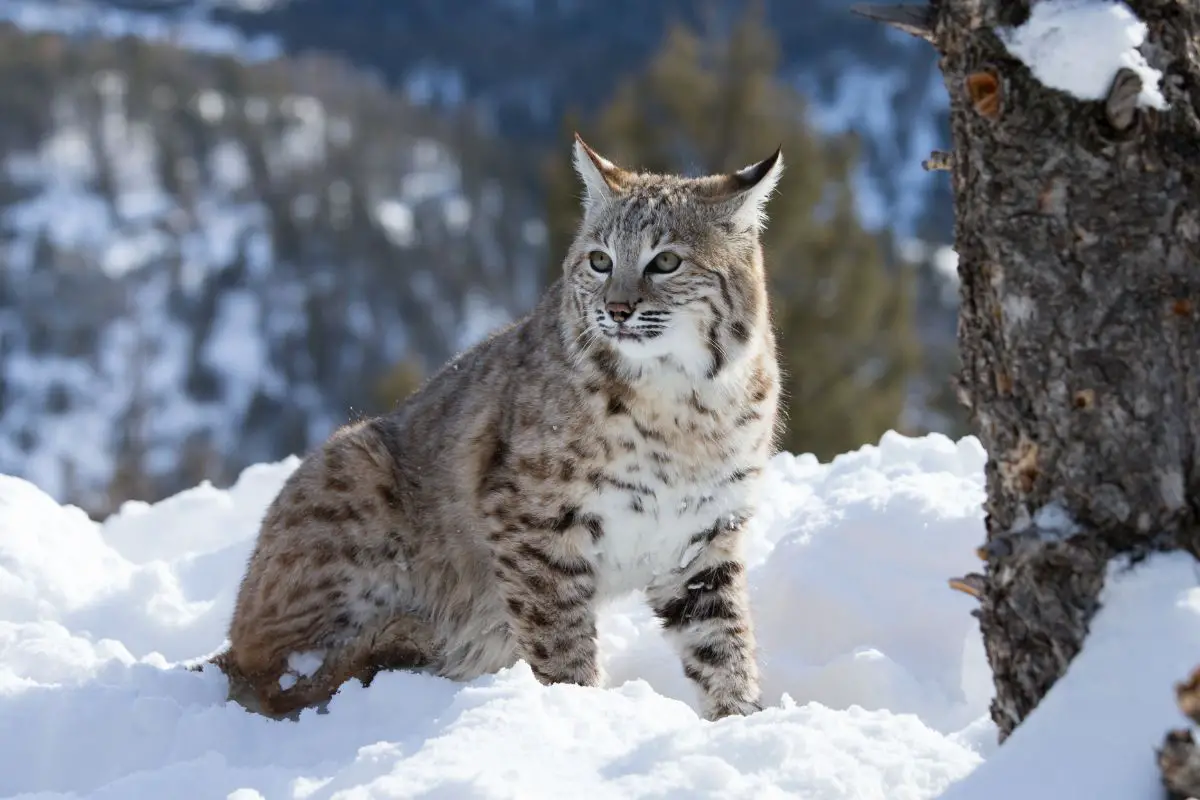
What Is An Interesting Fact About Bobcats?
Bobcats will stalk their prey for 2 to 7 miles in order to get nice and close before making their move.
This is because they don’t like running over greater distances. A much better sprinter, they would prefer to get nice and close first before quickly pouncing.
Super fast, they can then reach top speeds of 34 mph to catch their prey.
What Is Another Name For The Bobcat?
The bobcat is known by a number of different names. The most common of these are wildcat, lynx cat, and bay lynx.
Due to their appearance, a lot of people easily mistake them for domesticated pet cats too. Some even refer to the bobcat as a mountain lion, but that’s completely wrong.
What Is The Biggest Threat To The Bobcat?
Unfortunately, the biggest threat to the bobcat is humans. Even though other animals hunt the bobcat, we are by far their biggest threat for a number of reasons.
First of all, there are people that trap, hunt, and kill the bobcat for their fur. Secondly, land development has seen the separation of bobcat territories.
Finally, landscape development has seen bobcat habitats completely destroyed.
What Is The Lifespan Of A Bobcat?
In the wild, bobcats live for up to 10 to 12 years. Some have even been known to live for up to 15 years. However, the average lifespan is only approximately 7 years. This is a result of habitat destruction, hunting, and other predators.
In captivity, bobcats live a lot longer. They can live for up to 25 years because they are constantly cared for and protected from predators. The oldest bobcat ever lived to the age of 32 years old.
What Is The Scientific Name For The Bobcat?
The bobcat has many names, but when it comes to its scientific name the species is known as Lynx rufus.
What Kingdom Do Bobcats Belong To?
The bobcat belongs to the animal kingdom. As you can imagine, this kingdom is made up of thousands upon thousands of animals, so what exactly is it?
Well, the animal kingdom is made up of animals that are multicellular, eukaryotic organisms. The animals that make up this group breathe oxygen, consume organic materials and reproduce sexually.
What Order Do Bobcats Belong To?
Bobcats belong to the Carnivora order. This is a group of mammals that consists of the most recent and common ancestors of all dogs and cats. Every descendent has evolved to specialize in the eating of flesh and meat.
What Phylum Do Bobcats Belong To?
Bobcats belong to the phylum Chordata. “All chordates possess five synapomorphies or primary characteristics”. During their adulthood, there comes a time that distinguishes them from other taxa.
What Type Of Covering Do Bobcats Have?
In terms of covering, bobcats are covered in thick, spotted fur. This helps them blend in with their environment and keep warm in colder climates.
Where Do Bobcats Live?
Most bobcats live in coniferous and deciduous forests across the United States. Other populations of bobcats are found in southern Canada and northern Mexico.
Other habitats they live in include marshlands, desert edges, wetlands, and swamps.
What Sound Does A Bobcat Make?
Check out our article on What Sound Does A Bobcat Make?
What Does Bobcat Poop Look Like?
Check out our article on Bobcat Scat Identification.
Final Thoughts
Bobcats are an elusive species of medium-sized cat that live right the way across the United States, northern Mexico, and southern Canada.
Now you’ve made your way through this guide, you should know absolutely everything there is to know about this wonderful species.
We’ve looked at the bobcat’s classification, characteristics, lifespan, diet and prey, anatomy, conservation status, and so much more.
The addition of our FAQs section should ensure you aren’t left with any unanswered questions.
While the bobcat population continues to grow and thrive, we are still the biggest threats they face.
Things might be okay for now, but with the continuous hunting and land development, the bobcat could face serious challenges in the future if we don’t act now.
By all doing our little bit to help, we can ensure this stunning cat population continues to thrive across our country.
- Sink Your Teeth Into This: Analyzing the Powerful Lion Bite Force - September 8, 2023
- Siberian Tigers: Everything You Need To Know - September 4, 2023
- Do Lions Eat Humans? Understanding Lion Aggression and Risks - September 4, 2023

